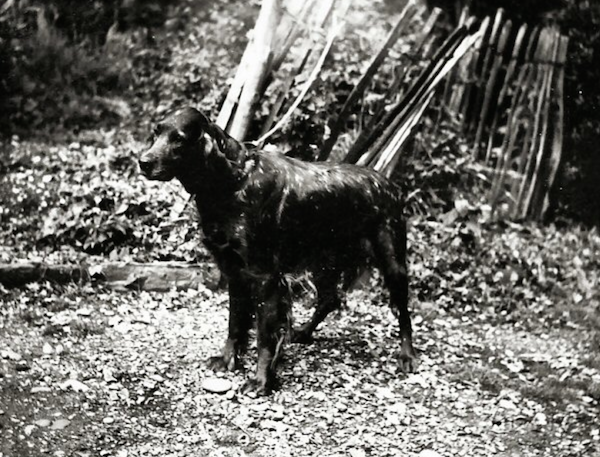
It’s probably the only coat color/pattern in a dog breed named after the weather.
The first Irish Setters were mostly red and white, a combination favored by hunters for being easy to spot in the field. In the 18th century, however, there were other colors thought to be variations: The solid red Irish Setter, and a rarer coat that was all red but for a sprinkling of white spots known as the “Shower of Hail,” or simply “hail.” The spots were also referred to as hairs, flecks, speckles and dots, and dogs who had these coats seemed more prevalent to the north-west coast of Ireland. If old handwritten notes are to be trusted, Jan Hessterman wrote in the 1930s that the coat color/pattern was noted in 1869, his source Colonel J.K. Millner, one of the founders of The Irish Red Setter Club in 1882.
The color/pattern was thought to have vanished altogether, but in the 1970s, reports of the odd “hail puppy” came out of New Zealand, and in 1997, a “hail” appeared in a litter of all-red puppies. We came across a blog that reported that as recently as 2013, a litter of ten puppies born in the Netherlands included six with “shower of hail” markings. We weren’t able to find follow up information as to whether the “hail” faded away or remained on the pups into adulthood.
Genetically speaking, one source suggests that the “Shower of Hail” markings could be a variation of the white modifier gene where the ability to turn off the red pigment in certain cells is reduced, but another source wondered if it couldn’t be another gene altogether, and that the “Irish Shower of Hail” could be a third Irish breed (we couldn’t tell if this was written in jest).
Interested readers will want to see an article posted on Facebook by the Irish Setter Club of Western Australia.
Update: We’ve amended our post title after having learned that other breeds also have a similar pattern. There are evidently references to “hailstone” Labrador Retrievers in old breed material, as well!
Image of the Irish Setter, “Hartsbourne Flame,” showing a “Shower of Hail” pattern found on Pinterest and happily credited upon receipt of information.

Fascinating! Where do you FIND this stuff? I guess it is similar to ticking in reverse? Instead of little black dots under the white, it’s little white dots over the red?
We came across this pearl ages ago, Sharyn, and saved if for when we could get more information about it. We still feel sure there’s much more to the story (let alone the genetics of the pattern) and hope Irish Setter and/or Irish Red and White Setter folks weigh in with what they know. In the end, we rely heavily on breed owners, themselves, to share info about their breed. There’s so much information about our own dogs that we all take for granted, but that would be fascinating to everyone else.
Here’s an example of ticking.
Aha – a great future post, thanks, Sharyn!!
Thanks for sharing, very fascinating. I own a Red Setter and a Red and White Setter. Ironically on my Red Setter who has pedigree from both American and British Lines, there are subtle “grey/silver” hairs around his neck and down around his front. I would not say there are spots or flecks but more like strands of silver that pop out when you put your hands through the coat. I have often wondered these hairs came from.
Our Irish has similar
There are references to hailstone Labradors in older breed material also. Same small white spotting pattern.
Thanks, Kerry, we’re going to have to amend this post!!
I am the son of William gaynor. And we both had an interest in red and red and white Setter s. And my father found 2 red setter s .with faint shower of hail .1990s east galway. William and I made a painted sculpture of red setter. Working type in shower of hail coloration. .William also sculpted red and white Setter. And red setter. Resin bronze
We feel like we’ve just heard from royalty, Joe. Your dad was an important player in the history of this breed, and we are honored to hear from you. We’d sure like to see a photo of the sculpture you did!
Very informative. And thanks for the article. Joe Gaynor. I’m on Facebook
Is this similar or the same as “snowflakes” in greyhounds? This photo is an extreme case. Some of them have much less spotting.